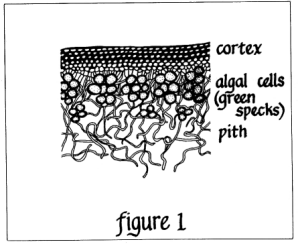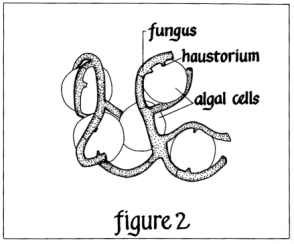
[click to enlarge]
| Online Library: | Title | Author | California | Geology | History | Indians | Muir | Mountaineering | Nature | Management |
Yosemite > Library > Yosemite Nature Notes > 47(3) > Welcome to the Waldorf Haustoria >
Next: Nursing Bears • Contents • Previous: Wawona Birds
Steve Gold
Many visitors to Yosemite wonder — what is that chartreuse growth on the trunks and branches of the pines, firs, and cedars? Often it is referred to as “that green moss” by Park visitors who are asking me if it is harming the trees. It is not a moss growing there in the virtual desert of a tree’s trunk. In fact, I am hard pressed to tell the inquirer that it is a plant at all.
If we were to cut a thin cross section from this branching growth, and examine it under a microscope, its hidden secret would be revealed. Enclosed by the brightly colored outer cortex is a dense pith of compacted and interwoven threads. The center may be less dense, or even hollow. Scattered throughout this white mass, most abundantly just below the cortex, are small green specks (fig. 1).

[click to enlarge] |
Focusing our attention on a single green speck, we increase the magnification until its structure becomes discernable — it is a cell containing green chloroplasts; the organelles possessing the photosynthetic pigment chlorophyll. Ah ha!! If it can photosynthesize, producing its own food using the sun’s energy to power the food factory, it must be a plant! In fact, this minute green cell is one of the most ancient of plants: a green algae.
But what is algae doing on the side of a tree trunk? They need moist, sheltered environments — in oceans, damp soil, lakes, and streams. How could it survive on the sun baked skin of a pine?
If we move our specimen slightly, so that we are looking at the white threads, another discovery strikes us. These threads are also made of cells, joined end-to-end instead of solitary, and without any chlorophyll. Unable to manufacture their own carbohydrates, these cells must take their nourishment from other sources. Similar threads can be found elsewhere in nature — on bread, running through rotten logs, in soil, even on damp carpets. These threads are the body of a fungus — an organism which is neither plant nor animal, but belongs to a separate kingdom of parasitic or saprophytic organisms.
Moving the microscope slide once more, and switching to a higher power, let’s examine the edge of an algal cell (fig. 2). The fungus is wrapped all around it, and actually penetrates the alga with a specialized organ called a haustorium. It is here that the key interaction between fungus and alga takes place. Through some unknown persuasion, the fungus causes the alga to produce extra quantities of the sugar ribitol. This sugar is produced by an alga on its own only in very small amounts. The fungus absorbs this sugar, and quickly converts it to manitol, another sugar, but one that is not usable by the alga. Manitol is the fuel that powers the metabolic engines of the fungus.

[click to enlarge] |
The alga feeds the fungus. What does the alga get out of the deal? Protection, for one thing. The fungus surrounds the alga, and screens out the ultraviolet radiation with its bright outer pigmentation. In addition, the miles of thread comprising the fungal body has a very large surface area, enabling rapid absorption of water and atmospheric trace elements, some of which are then passed on to the alga. Almost all nutrients are taken from the air, the tree is little used except for support. Only through this mutual protection and feeding are these two separate organisms able to survive in the unhospitable environment of a tree trunk.
This green wonder of cooperation is called a lichen. More specifically, its name is Letharia, the Wolf Lichen. There are many types of lichen, ranging from the leafy arctic groundcover known as Reindeer Moss (really a lichen), which may take 100 years to grow and is the caribou’s equivalent of wheat, to the brightly colored crusts of life that embellish rocks high above the Sierra timberline.
Lichens have a long and interesting role in the affairs of humans. Many lichens yield dyes when variously treated. The original Scottish tweeds were colored by a lichen dye soluble only in ammonia. In those days, ammonia was not readily available in large quantities, so all the men of a village would urinate into a large vat. Into this fermenting mess, the lichen and material to be dyed were then placed. Not surprisingly, this colorful and odiferous practice has been replaced by more mundane, modern methods.
Due to their absorbent properties, certain lichens have been used for padding material, or as a dressing for wounds. Also, because of these attributes, lichens today play an important role in the cycling of atmospheric pollution. Not only does the fungal partner absorb useful materials from the air, but harmful ones as well, including radioactive fallout. Most fallout comes to earth near the poles, where in some places Reindeer “Lichen” forms a near continuous carpet over the earth. Such materials as cesium, and stronium-90 become concentrated within the lichen. Since the caribou subsist almost entirely on this lichen, they accumulate these radioactive substances in their bodies, concentrated by a lifetime of eating the lichens. What of the wolves, grizzlies, and people that dine on the caribou? Some Eskimos are so affected by the bone-brittling poisoning from cesium that they can break a leg trying to pull on a boot.
The relationship between the fungus and algae in a lichen is called symbiosis — a mutual give-and-take relationship, in which each partner has something to offer, something to gain. Lichens in turn are involved in a larger relationship with air, soil, water, and fellow organisms; using some perhaps as support, providing nutritional or even economic support for others.
We too are involved with our fellow organisms; and the earth and the sun which supports us all. Could our relationships with cats, cattle, or corn be compared to a lichen symbiosis? Surely we are all tangled up together — dependent upon each other in one way or another.
Lichens make me think of human civilization. If the fungus took too much from the alga; alga, then fungus, would perish. Does not the earth support us as the fungus is supported by the alga? Do we give the earth anything in return to make it a symbiosis, or is it more of a parasitic relationship? Whether consciously or not, the fungus cares for its host.
Have we as much self-preserving wisdom as that microscopic thread?
Next: Nursing Bears • Contents • Previous: Wawona Birds
| Online Library: | Title | Author | California | Geology | History | Indians | Muir | Mountaineering | Nature | Management |
http://www.yosemite.ca.us/library/yosemite_nature_notes/47/3/lichen.html